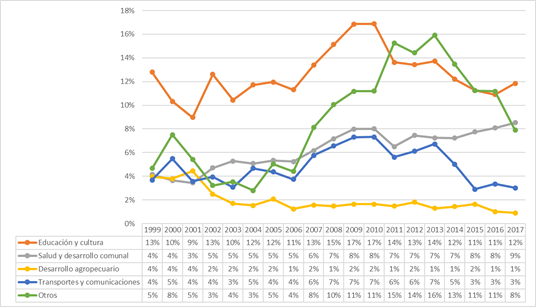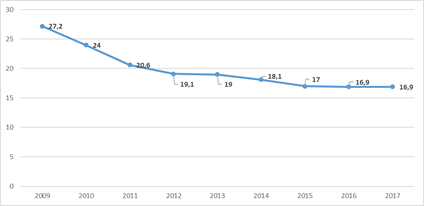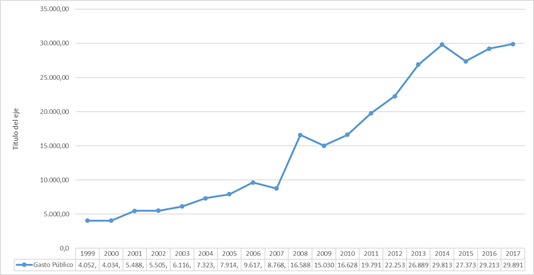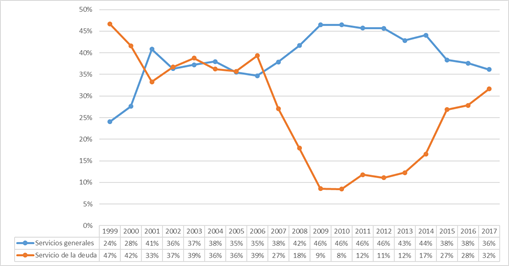Introduction
At the moment of defining the concept of poverty, there is no consensus that establishes this definition in a homogeneous way, generating different approaches and interpretations, despite this, in its more general understanding, it enters into the description of an individual's inability to reach a level of wellness. Boltvinik & Hernández (1999), states that the term necessity is essential when defining conceptually poverty. The Economic Commission for Latin America and the Caribbean - ECLAC, refers to this term defining the need as a lack of material goods or services that are essential for an individual to live and perform as a member of a society.
For its part, the United Nations Development Program (United Nations, 1997), defines the term poverty under a multidimensional criterion referring to the refusal of people to live a tolerable life, understanding this as having adequate food, a place to live, enjoy health, have education, have a decent standard of living, have personal security, political freedom and association, respect for human rights, access to productive and well-paid work, and participation in life community.
The Organization for the United Nations - UN through its UNDP program enables and enforces its definition of poverty before the design of the Multidimensional Poverty Index - IPM in 2010 in collaboration with the Oxford Poverty and Human Development Initiative - OPHI, The aforementioned indicator identifies deficiencies such as the level of households and people in the areas of health, education and living standards. For this purpose, it uses household surveys, and, unlike the Human Development Index - HDI adjusted by Inequality, all the indicators that make up the calculation of the IPM must be extracted from the same survey, for this each member of a family is classified as poor or not poor depending on the number of deprivations that your home experience.
For the National Institute of Statistics and Census of Ecuador - INEC, poverty indicators constitute a basic tool in the planning, evaluation, monitoring and design of social policies. Castillo & Jácome (2015), describes that the traditional approach that sustains the concept of well-being is generated in the neoclassical economy, where well-being is understood as the satisfaction of preconceived needs as unlimited in an environment of limited resources. Under the premise of consumer supremacy, interest is placed on the maximization of consumption and consequently on the maximization of the production of goods and services as a mechanism to increase well-being.
The IPM proposes to identify simultaneous deprivations suffered by the individual in the enjoyment of his rights. The National Institute of Statistics and Censuses of Costa Rica - INEC (2015), describes as benefits that this method presents, allowing the index to be disaggregated for each dimension, in order to analyze which indicator has the greatest weight in the measurement of poverty. Jácome (2015), mentions that currently multidimensional poverty indicators are applied in the region as a public policy tool.
The importance of this document lies in establishing the relationship of this indicator with the expenditure made by the state, understanding the existence of an interest on the part of developing countries to intervene in indicators that denote economic development under the criterion of increase persistent population welfare. Under this premise it is intended to establish the current behavior of this multidimensional index, its relationship with Ecuadorian public spending and its projection in the short term future. This empirical proposal can clear theoretical ideas of the dependence of the IPM with the interaction of the national economy.
The design of the research embodied in the document seeks to characterize the importance of the use of the IPM by reviewing the literature of authors who have developed the subject under study, and then establishing the methodological framework that encompasses the development of the research, subsequently the results of The investigation will be manifested before the characterization of the behavior of the indicator under study, its relationship with Public Expenditure and its projection in the short term.
The conclusions contain the analysis of the environment in which the research results were developed. The reference houses the list of works cited in this document and that have been used to sketch the study and the results of the same.
Spicker (2009), identifies about twelve postulates to the word poverty and this author brings them into three categories of material, economic and social conditions. Neoclassical theory classifies poverty in a one-dimensional structure based on the resources that an individual possesses, a premise traditionally evaluated by income and consumption. Understanding that greater money is greater utility and therefore greater happiness. Given this analysis, poverty under this theory is defined as the lack of sufficient monetary resources to generate a minimum income or consumption that allows the person to reproduce their livelihoods (Castillo & Jácome, 2015).
Until 1980, poverty in Latin America was measured from an economic approach with indirect methods, based on the measurement of income or expenses, in relation to a capacity that families or individuals should present to meet their needs. This criterion gives rise to the poverty line method (INEC, 2015).
Since 1980 the criticism of the monetarist approach motivated the establishment of new multidimensional approaches to poverty. Among the first methodological efforts we find that of poverty due to Unsatisfied Basic Needs - NBI, introduced in 1981 by Paul Streeten and implemented by ECLAC. Kaztman (1989), later adds monetary poverty to the NBI model to establish a new typology, understanding the existence of a possible transitory or chronic state of poverty.
Sen (2000), questions the theory of neoclassical economics, with the capabilities approach that motivates "the need to release the analysis of welfare and inequality to the confinement of the space of income or possession of goods." This contribution is based on the ability of the individual to contribute to the full development of society. With this approach a rupture of the monetarist paradigm is established and focuses its analysis on human capacities, these being deeper than that generated by the markets, that is, a new conception of poverty.
It should be understood that Sen's contribution in terms of “capabilities” presents a multidimensional approach in itself, knowing that capabilities are interconnected by facilitating their joint development, adequate nutrition is a necessary condition for intellectual development and productive employment, in the same way the habitat conditions of the home affect the achievement of minimum levels of health.
In 2010, for the twentieth anniversary of the publication of the Human Development Report, the IPM is presented as a new indicator, prepared by UNDP in collaboration with OPHI, a methodology developed by Alkire & Foster (2007, 2011). This multidimensional approach to poverty seeks an adequate identification of population groups in a state of deprivation of rights, allowing the population to be characterized for the use of public policy and the efficient location of resources destined for poverty.
The National Council for the Evaluation of the Social Development Policy of Mexico (México. Consejo Nacional de Evaluación de la Política de Desarrollo Social, 2014), describes poverty as a multidimensional phenomenon that affects people's lives, denying equal opportunities and excluding them from the economic, social and cultural activities of their community. Under this criterion, poverty is not supported only by low income levels, but in addition to this, the precarious living conditions of the population, such as the inability to access adequate food, educational services, health services, to formal sources of employment, to decent housing, to a pension, among others. This condition can promote that families and individuals stay in poverty conditions for several generations.
This concept is part of the theory of development, with contribution of definition given by Leibenstein (1957). The contributions of these authors contributed to the development of macroeconomic models, such as economic and microeconomic growth, as the individual agent; which seek to explain the presence of heterogeneous accumulation trajectories, where some of these present poverty traps with various self-reinforcing mechanisms - economies of scale, positive externalities, the presence of complements, that there is imperfect competition, the failure of some markets and the recognition of the importance of the institutional framework to regulate economic transactions.
Given this criterion, the Ecuadorian State defines poverty as the absence of well-being, understanding this as a phenomenon that manifests the violation of human rights, the result of unjust social and political relations.
This indicator considers three dimensions of education, health and standard of living, and 10 indicators: years of education of household members, attendance of children at school, nutrition, experience of child mortality in the home, access to electricity, water potable, adequate sanitation, clean energy for cooking, floor that is not dirt and at least two assets (durable consumer goods) small.
Arrobo & Zamora (2017), mentions that the proposal for the application of the IPM in Ecuador was made in 2016 by the INEC with data obtained from the National Survey of Employment, Unemployment and Under-Employment - ENEMDU, based on the methodological design of Alkire et al. (2007, 2011). This index in its applied version for Ecuador groups 4 categories that assess the deprivation of rights of people in education; work and social security; health, water and food; and habitat, housing and healthy environment. Understanding the construction of its dimensions in the design of public policy that is part of the Good Living specified in articles 12 to 34 of the Constitution of Ecuador (Ecuador. Asamblea Nacional Constituyente, 2008).
Castillo & Jácome (2015), describes that each dimension has a relatively similar weight to each other for the design of the IPM, each of which provides 25% of the percentage weight for the design of the indicator.
Castillo & Jácome (2015), makes reference that, at present, multidimensional poverty indicators are applied in the region as a public policy tool, in Mexico carried out by the National Council for the Evaluation of Social Development Policy (México. Consejo Nacional de Evaluación de la Política de Desarrollo Social, 2014), in Colombia by Angulo, Díaz & Pardo (2011), through the National Administrative Department of Statistics and in Chile by the Ministry of Social Development (2015).
In terms of the subject addressed, the research carried out on the indicator varies depending on the methodology applied to the design of the index, the establishment of the analysis in qualitative terms, its relationship with other methods of poverty analysis and income, and The theoretical and evolutionary analysis of the measurement of poverty that allows to justify and empower worldwide the application of multidimensional indices and especially the indicator under study.
Guerrero & Lara (2012), generate alternative evaluations of the IPM estimates based on the modification of the Consumer Price Index - CPI for the case of Mexico (México. Consejo Nacional de Evaluación de la Política de Desarrollo Social, 2014), establishes under a theoretical argument the methodology for the measurement of the IPM.
Amaral, Coelho & Lima (2015), developed and applied the methodology of the indicator in the state of Ceará in Brazil, putting the environment under evaluation. Castillo & Jácome (2015); and Jácome (2015), theoretically analyze the methodological application of the IPM in the case of Ecuador under the method of Alkire & Foster (2007, 2011).
Morais, et al. (2016), applies the indicator taking it to study contexts adapted to rural and urban areas. Colacce & Tenenbaum (2016), seeks to establish the IPM having as a study universe the children and adolescents of Uruguay.
Moreno-Gómez, Duarte Gómez & Barrientos-Gutiérrez (2017), apply the IPM in vulnerable communities, which will allow to evaluate, later, the impact of development in a free zone. Arrobo & Zamora (2017), theoretically analyzes the application of the indicator in Ecuador.
The series of authors who have evaluated the multidimensional poverty index have focused their research on the search for a theoretical and applicative justification of the indicator, even leading it to relate it to one-dimensional variables and other multidimensional methods. This research intends from the empirical field to evaluate the behavior of the indicator and relate it to the variable public expenditure that in the case of Ecuador theoretically converges in an indispensable way for the improvement of the IPM.
Materials and methods
The present investigation is framed in a type of inductive reasoning through which, the use of statistical tests allowed us to analyze the IPM and establish its relationship with public spending in Ecuador. A process with an only method is outlined as a process of research development with an empirical-analytical paradigm according to Bacon (1949), allows to reflect the reality of the most faithful and neutral way possible of the research conducted.
For the research design of the document, an annualized time series database was established with an evaluation period from 2009 to 2017 of the variable multidimensional poverty index - IPM and from 1999 to 2017 of the variable Public Expenditure of Ecuador. The methodological proposal of the research proposes a descriptive statistical analysis and a Pearson correlation matrix that determines the relationship between the variables under study.
Pearson's correlation coefficient, used for quantitative variables at a minimum interval scale, measures the degree of co variation between different linearly related variables, to establish whether there are strongly related variables. This indicator shows absolute values that range between 0 and 1.
If the sign of this index is considered as a correlation coefficient that ranges from -1 to +1, the magnitude of the relationship must be specified by the value of the coefficient, reflecting the sign as the direction of that value. Arguing how strong is a ratio of +1 (perfectly positive) and -1 (perfectly negative).
Results and discussion
Jácome (2015), defines that the multidimensional poverty index results from the intersection between rights promulgated by the Magna Letter and the information available in the Rural Urban Employment and Unemployment Surveys - ENEMDUR for each of its dimensions. Under this premise each dimension shows different information criteria.
In the “water” dimension, the constitution describes in its article 12 that the human right to water is fundamental and inalienable, which defines that the dimension to be evaluated must be measured in terms of permanent access and quality of water.
In the case of "food and nutrition", the State in article 13 of the constitution guarantees the right to safe and permanent access to healthy, sufficient and nutritious food. There is no variable that allows calculating indicators of nutrition of the population, so it presents as a variant in its analysis the use of the income indigence line, understanding that said base is constructed from the basic basket equivalent to the minimum caloric consumption.
In the “healthy environment” dimension, Ecuador in its Magna Letter establishes the right of the population to live in a healthy and ecologically balanced environment, in its article 14. The ENEMDUR does not generate relevant information in the quantification of compliance with said right.
In the variable "communication and information" article 16 of the constitution of Ecuador establishes as the right of the population information and communication that, among other things, must be, in a free, intercultural, participatory manner, with access to information technologies and communication In order to establish the quantification of this indicator, it is proposed to measure access to the tools that allow the use of information, so that the use of goods or services such as cell phones, computers and the Internet, as well as the possession of television or radio are measured.
The “culture and science” dimension, expresses among the articles from 21 to 25 of the constitution the right of people to culture and science, who seek to build and maintain their own cultural identity, aesthetic freedom, access their cultural heritage, develop its creative capacity, to the dignified and sustained exercise of cultural and artistic activities, to participate in the public space, promotion of equality in diversity, recreation, sports and leisure time. In the absence of information by ENEMDUR, the dimension within the calculation is omitted.
In the case of "education" the constitution defines it as an inexcusable duty of the State, which must guarantee universal access, permanence, mobility and egress without any discrimination; In addition to the compulsory at the initial level, basic and baccalaureate or its equivalent, extending the gratuity to the third level. For its analysis it is considered school attendance and lag for children under 18, minimum schooling between 18 and 64 years and illiteracy 65 years and older.
In the variable “habitat and housing” the Magna Letter defines the right of people to a safe and healthy habitat, adequate and dignified housing, and the enjoyment of the city and public spaces. To obtain this indicator, overcrowding indicators, adequate excreta disposal system and garbage disposal are taken.
In the “health” dimension, article 32 of the constitution describes the intersection of this dimension with others. Despite this, it can be quantified through universal access to comprehensive health care services, and sexual and reproductive health, with quality, efficiency and effectiveness.
The dimension "work and social security" within the Magna Letter is recognized as a social right and duty, guaranteeing workers, full respect for their dignity, a decent life, fair remuneration and remuneration and the performance of healthy work and freely chosen or accepted. At the same time, the constitution defines social security as a right of all people, guaranteeing its exercise to people who perform unpaid work, self-sustaining activities and self-employed and unemployed work. For the evaluation of the law, the indicators of child labor, unemployment, the condition of activity as defined by the National Institute of Statistics and Censuses - INEC, and access to social security, retirement and non-contributory pensions are taken into account.
All the dimensions that make up the IPM of Ecuador are considered rights to be guaranteed by the state in its Magna Letter with the objective of satisfying the basic needs of the population. The Ecuadorian state provides mentioned services considered as universal rights for its population through the use of public spending.
Previous studies such as those of Castillo & Jácome (2015); and Jácome (2015) have contributed by generating the multidimensional poverty index for Ecuador from 2009 to 2017, describing a constant decrease of said indicator within the study period by 10 points, results that are put to the discussion against the theories that define the poverty (Fig. 1).
The period under study is framed within the period of government of the Ec. Rafael Correa Delgado who doubled the public expenditure within the period under study and increased its value seven times before the public expenditure recorded in 1999 (Fig. 2). This criterion is the basis for the existence of an influence generated by Ecuadorian public spending towards the IPM, with the objective of improving the country's economic development indicators.
In spite of concentrating around 60% of the total public expenditure on debt service and general services, the increase in terms of gender expenditure values that, despite maintaining average values of participation in education, health, agricultural development, transportation and communication, and others its real contribution is similar to that generated by the total public expenditure “the public expenditure doubled within the period under study and increased its value seven times before the public expenditure recorded in 1999”.

Fig. 4 Public Expenditure Ecuador 1999 - 2017. Education, Health, Agricultural Development, Transportation and Communication, and Others.
To establish a relationship between (Fig. 3 and 4) the IPM and Ecuadorian public spending, a descriptive statistical summary table was generated for each of the variables under study. This includes measures of central tendency, variability, and so, with particular interest, standardized bias and standardized kurtosis, which can be used to determine if the sample comes from a normal distribution; the values of these statistics outside the range of -2 to +2 indicate significant deviations from normal, which tends to invalidate any statistical procedure. The data under evaluation show no standardized bias and standardized kurtosis values outside the expected range.
Pearson's correlation table presents the range of these correlation coefficients ranging from -1 to +1, measuring the strength of the linear relationship between the variables. This table shows the number of data pairs used to calculate each coefficient, the P-value that proves the statistical significance of the estimated correlations.
P-values below 0.05 indicate significantly different correlations from zero, with a confidence level of 95.0%. The table shows a strong inverse relationship between the IPM and public spending in Ecuador.
Conclusions
The results continue to contribute to the study of the subject due to its limited approach in national studies. It is necessary to generate other studies of the subject with various methodologies that strengthen the development and causal understanding of it.
The IPM is an indicator that presents versatility and importance when measuring poverty, thanks to its multidimensional ability to assess the population's environment. This indicator allows to generate policies with specific orientation to the elimination of poverty thanks to its multidimensionality, contributing to the economic development of the countries.
There is a strong inverse relationship between the IPM and Ecuadorian public spending. Understanding that the state assumes the satisfaction of the basic needs that the index under study evaluates and that they are in the constitution of the republic registered as natural rights acquired by all those who inhabit the Ecuadorian territory.
Within the study period there was an increase in public spending in Ecuador, the 100% increase in the study period is related to the notable decrease in the IPM in 10 points.
The results continue to contribute to the understanding of the topic given the diversity of methodologies and analysis found in other studies. It is necessary to generate other studies that evaluate the relationship and incidence of the increase in public debt within the IPM study period and on issues that determine the differences between economic growth and economic development for the Ecuadorian case.

















